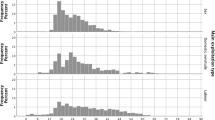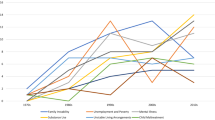Abstract
Female sex workers (FSWs) are disproportionately affected by both HIV and gender-based violence, such as that perpetrated by clients (CPV). We used a structural determinants framework to assess correlates of physical or sexual CPV in the past 6 months among FSWs in the Mexico/U.S. border cities of Ciudad Juárez and Tijuana. Bivariate and multivariate logistic regression analysis identified individual, client, interpersonal, work environment and macrostructural factors associated with recent CPV. Among 496 FSWs, 5 % experienced recent CPV. Witnessing violence towards other FSWs in one’s neighborhood (aOR 5.6, 95 % CI 1.8–17.2), having a majority of foreign (aOR 3.5, 95 % CI 1.4–8.4) or substance using (aOR 4.0, 95 % CI 1.5–10.4) clients, and being a street worker (aOR 3.0, 95 % CI 1.1–7.7) were independently associated with recent CPV. Our findings underscore the vulnerability of FSWs and the need to design policies and interventions addressing macro-level influences on CPV rather than exclusively targeting individual behaviors.
Resumen
Las mujeres trabajadoras sexuales (MTS) se ven afectadas de manera desproporcionada por el VIH y la violencia de género, tal como la que reciben por parte de sus clientes. Utilizamos un marco con determinantes estructurales para evaluar los correlatos de la violencia física o sexual por parte de clientes en los últimos 6 meses en MTS en Ciudad Juárez y Tijuana, ciudades en la frontera entre México y Estados Unidos. Análisis de regresión logística bivariante y multivariante identificaron factores individuales, de los clientes, interpersonales, del entorno laboral y macroestructurales que están relacionados con el haber vivido la violencia por parte de clientes recientemente. De las 496 MTS, el 5 % experimentó violencia por parte de clientes recientemente. El ser testigo de la violencia contra otra MTS en su colonia (aOR 5.6, 95 % CI 1.8–17.2), el tener en su mayoría clientes extranjeros (aOR 3.5, 95 % CI 1.4–8.4) o que usan sustancias (aOR 4.0, 95 % CI 1.5–10.4) y el trabajar en la calle (aOR 3.0, 95 % CI 1.1–7.7) estuvieron relacionados de manera independiente con el haber vivido la violencia por parte de clientes recientemente. Nuestros hallazgos subrayan la vulnerabilidad de las MTS y la necesidad de diseñar políticas e intervenciones que aborden las influencias al nivel macro en la violencia por parte de los clientes en lugar de enfoque exclusivo en los comportamientos individuales.
Similar content being viewed by others
References
Tounkara FK, Diabate S, Guedou FA, Ahoussinou C, Kintin F, Zannou DM, et al. Violence, condom breakage, and HIV infection among female sex workers in Benin, West Africa. Sex Transm Dis. 2014;41(5):312–8.
Ramesh S, Ganju D, Mahapatra B, Mishra RM, Saggurti N. Relationship between mobility, violence and HIV/STI among female sex workers in Andhra Pradesh, India. BMC Public Health. 2012;12:764 .
Jewkes RK, Dunkle K, Nduna M, Shai N. Intimate partner violence, relationship power inequity, and incidence of HIV infection in young women in South Africa: a cohort study. Lancet. 2010;376(9734):41–8.
Decker MR, Wirtz AL, Moguilnyi V, Peryshkina A, Ostrovskaya M, Nikita M, et al. Female sex workers in three cities in Russia: HIV prevalence, risk factors and experience with targeted HIV prevention. AIDS Behav. 2014;18(3):562–72.
Baral S, Beyrer C, Muessig K, Poteat T, Wirtz AL, Decker MR, et al. Burden of HIV among female sex workers in low-income and middle-income countries: a systematic review and meta-analysis. Lancet Infect Dis. 2012;12(7):538–49 Epub 2012/03/20.
Deering KN, Amin A, Shoveller J, Nesbitt A, Garcia-Moreno C, Duff P, et al. A Systematic Review of the Correlates of Violence Against Sex Workers. Am J Public Health. 2014;104:e42–54.
Decker MR, Wirtz AL, Pretorius C, Sherman SG, Sweat MD, Baral SD, et al. Estimating the impact of reducing violence against female sex workers on HIV epidemics in Kenya and Ukraine: a policy modeling exercise. Am J Reprod Immunol. 2013;69(Suppl 1):122–32.
Chersich MF, Luchters SM, Malonza IM, Mwarogo P, King’ola N, Temmerman M. Heavy episodic drinking among Kenyan female sex workers is associated with unsafe sex, sexual violence and sexually transmitted infections. Int J STD AIDS. 2007;18(11):764–9.
Odinokova V, Rusakova M, Urada LA, Silverman JG, Raj A. Police sexual coercion and its association with risky sex work and substance use behaviors among female sex workers in St. Petersburg and Orenburg, Russia. Int J Drug Policy. 2014;25(1):96–104.
Zhang C, Li XM, Stanton B, Hong Y, Chen YY, Shan Q, et al. Alcohol use and client-perpetrated sexual violence against female sex workers in China. Psychol Health Med. 2013;18(3):330–42.
Hong Y, Zhang C, Li X, Liu W, Zhou Y. Partner violence and psychosocial distress among female sex workers in China. PLoS One. 2013;8(4):e62290.
El-Bassel N, Witte SS, Wada T, Gilbert L, Wallace J. Correlates of partner violence among female street-based sex workers: substance abuse, history of childhood abuse, and HIV risks. AIDS Patient Care STDs. 2001;15(1):41–51.
Ulibarri MD, Strathdee SA, Lozada R, Magis-Rodriguez C, Amaro H, O’Campo P, Patterson TL. Prevalence and correlates of client-perpetrated abuse among female sex workers in two Mexico-U.S. border citeis. Violence Against Women. 2014;20(4):427–45.
Shannon K, Kerr T, Strathdee SA, Shoveller J, Montaner JS, Tyndall MW. Prevalence and structural correlates of gender based violence among a prospective cohort of female sex workers. BMJ. 2009;339:b2939.
Schwitters A, Swaminathan M, Serwadda D, Muyonga M, Shiraishi RW, Benech I, et al. Prevalence of rape and client-initiated gender-based violence among female sex workers: Kampala, Uganda, 2012. AIDS Behav. 2014;19:S68–76.
Raghavan C, Mennerich A, Sexton E, James SE. Community violence and its direct, indirect, and mediating effects on intimate partner violence. Violence Against Women. 2006;12(12):1132–49.
Cunradi CB. Intimate partner violence among hispanic men and women: the role of drinking, neighborhood disorder, and acculturation-related factors. Violence Vict. 2009;24(1):83–97.
Reed E, Silverman JG, Welles SL, Santana MC, Missmer SA, Raj A. Associations between perceptions and involvement in neighborhood violence and intimate partner violence perpetration among urban, African American men. J Community Health. 2009;34(4):328–35.
Strathdee SA, Lozada R, Semple SJ, Orozovich P, Pu M, Staines-Orozco H, et al. Characteristics of female sex workers with US clients in two Mexico-US border cities. Sex Transm Dis. 2008;35(3):263–8.
UNAIDS. UNAIDS. 2012. Human development report. 2012. http://www.unaids.org/en/regionscountries/countries/mexico/. Accessed 28 Feb 2014.
CENSIDA. La epidemia del VIH y el sida en Mexico. 2013.
Beletsky L, Martinez G, Gaines T, Nguyen L, Lozada R, Rangel G, et al. Mexico’s northern border conflict: collateral damage to health and human rights of vulnerable groups. Pan Am J Public Health. 2012;31(5):403–10.
Deering KN, Bhattacharjee P, Mohan HL, Bradley J, Shannon K, Boily M-C, et al. Violence and HIV Risk among female sex workers in Southern India. Sex Transm Dis. 2013;40:168–74.
Erausquin JT, Reed E, Blankenship KM. Police-related experiences and HIV risk among female sex workers in Andhra Pradesh, India. J Infect Dis. 2011;204:S1223–8.
Platt L, Grenfell P, Bonell C, Creighton S, Wellings K, Parry J, et al. Risk of sexually transmitted infections and violence among indoor-working female sex workers in London: the effect of migration from Eastern Europe. Sexually Transm Infect. 2011;87(5):377–84.
Shannon K, Goldenberg SM, Deering KN, Strathdee SA. HIV infection among female sex workers in concentrated and high prevalence epidemics: why a structural determinants framework is needed. Curr Opin HIV AIDS. 2014;9(2):174–82 Epub 2014/01/28.
Pitpitan EV, Chavarin CV, Semple SJ, Magis-Rodriguez C, Strathdee SA, Patterson TL. Hombre Seguro (Safe Men): a sexual risk reduction intervention for male clients of female sex workers. BMC Public Health. 2014;14:475 Epub 2014/06/03.
Goldenberg SM, Strathdee SA, Gallardo M, Nguyen L, Lozada R, Semple SJ, et al. How important are venue-based HIV risks among male clients of female sex workers? A mixed methods analysis of the risk environment in nightlife venues in Tijuana, Mexico. Health Place. 2011;17(3):748–56 Epub 2011/03/15.
Wechsberg WM, Luseno WK, Lam WK. Violence against substance-abusing South African sex workers: intersection with culture and HIV risk. AIDS Care. 2005;17(Suppl 1):S55–64.
Shannon K, Csete J. Violence, condom negotiation, and HIV/STI risk among sex workers. JAMA. 2010;304(5):573–4.
Ulibarri MD, Strathdee SA, Ulloa EC, Lozada R, Fraga MA, Magis-Rodriguez C, et al. Injection drug use as a mediator between client-perpetrated abuse and HIV status among female sex workers in two Mexico-US border cities. AIDS Behav. 2011;15(1):179–85 Epub 2009/07/29.
Cepeda A, Nowotny KM. A border context of violence: Mexican female sex workers on the U.S.-Mexico border. Violence Against Women. 2014;20:1506–31.
Saggurti N, Jain AK, Sebastian MP, Singh R, Modugu HR, Halli SS, et al. Indicators of mobility, socio-economic vulnerabilities and HIV risk behaviours among mobile female sex workers in India. AIDS Behav. 2012;16(4):952–9.
Reza-Paul S, Lorway R, O’Brien N, Lazarus L, Jain J, Bhagya M, et al. Sex worker-led structural interventions in India: a case study on addressing violence in HIV prevention through the Ashodaya Samithi collective in Mysore. Indian J Med Res. 2012;135:98–106.
Argento E, Reza-Paul S, Lorway R, Jain J, Bhagya M, Fathima M, et al. Confronting structural violence in sex work: lessons from a community-led HIV prevention project in Mysore, India. AIDS Care. 2011;23(1):69–74 Epub 2011/01/11.
Pitpitan EV, Strathdee SA, Semple SJ, Chavarin CV, Magis-Rodriguez C, Patterson TL. Buffering syndemic effects in a sexual risk-reduction intervention for male clients of female sex workers: results from a randomized controlled trial. Am J Public Health. 2015;25:e1–6.
Beattie TS, Bhattacharjee P, Ramesh BM, Gurnani V, Anthony J, Isac S, et al. Violence against female sex workers in Karnataka state, south India: impact on health, and reductions in violence following an intervention program. BMC Public Health. 2010;10:476.
Acknowledgments
The authors respectfully acknowledge the participation of all the women in this study for making this work possible. We also thank the project coordinator, Kristen Meckel-Parker and the U.S.-Mexico bi-national study staff. Research reported in this publication was supported by the National Institute on Drug Abuse of the National Institutes of Health under award number R01DA029899. Dr. Strathdee is supported by a NIDA MERIT Award R37 DA019829. The content is solely the responsibility of the authors and does not necessarily represent the official views of the National Institutes of Health.
Author information
Authors and Affiliations
Corresponding author
Rights and permissions
About this article
Cite this article
Conners, E.E., Silverman, J.G., Ulibarri, M. et al. Structural Determinants of Client Perpetrated Violence Among Female Sex Workers in Two Mexico-U.S. Border Cities. AIDS Behav 20, 215–224 (2016). https://doi.org/10.1007/s10461-015-1111-1
Published:
Issue Date:
DOI: https://doi.org/10.1007/s10461-015-1111-1




